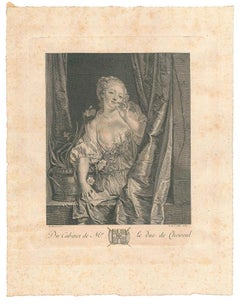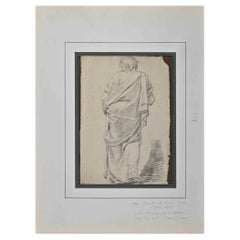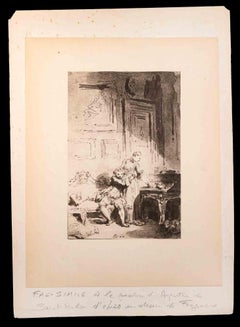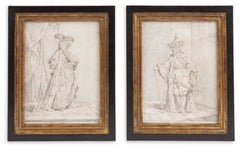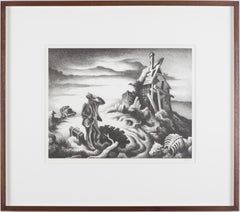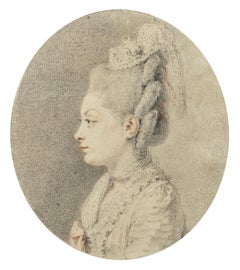Augustin de Saint-Aubin Art
French, 1736-1807
Augustin de Saint-Aubin was born on January 3rd 1736 into a family of artists: his father Gabriel-Germain (1696-1756) was the King's embroiderer and his six surviving siblings (Charles-Germain (born in 1721), Gabriel-Jacques (1724), Catherine-Louise (1727), Louis-Michel (1731), Athanase (1734) and Agathe (1739)) were also artists. The eldest of the boys, Charles-Germain, became a draughtsman and embroiderer like his father, Gabriel-Jacques? is considered one of the most brilliant draughtsmen of the 18th century, Louis-Michel became a painter at the Sèvres porcelain manufactory and Athanase an actor, while his two sisters were also talented draughtswomen.
During his lifetime Augustin de Saint-Aubin's fame as a draughtsman and engraver far out-shadowed that of his twelve-year-old elder brother Gabriel, but the Goncourt brothers initiated research into the French 18th century art sphere which gave back its pre-eminence to Gabriel’s works.
Initially trained by his brother Gabriel, the young Augustin continued his apprenticeship with the engraver Etienne Fessard (1714 - 1777) and very quickly set his sights on becoming an engraver.
Accepted to the Académie Royale in 1771, he was never admitted because he did not submit his reception piece. This did not prevent him from having a successful and very prolific career as an engraver, since his output is estimated at more than 1,300 engravings.
Portraits - whether drawn or engraved - constitute the best part of his work and also the most sought-after, particularly by the Goncourt brothers, who owned several portraits among the dozen or so drawings of Augustin de Saint-Aubin they had collected/in their collection.to
1
2
2
1
1
La Baiser Envoye - Etching by Augustin de Saint-Aubin -Mid 18th century
By Augustin de Saint-Aubin
Located in Roma, IT
La Baiser Envoye is a splendid etching realized around the mid-XVIII century in France by the engraver Augustin de Saint-Aubin (Paris, 1736 – 1807), belonging to an important dynasty...
Category
18th Century Modern Augustin de Saint-Aubin Art
Materials
Etching
Figure of Man - Original Pencil Drawing by Augustin de Saint-Aubin- 19th Century
By Augustin de Saint-Aubin
Located in Roma, IT
Figure of Man is an Original Pencil Drawing realized by Augustin de Saint-Aubin (1736-1807).
Good condition included a green and white cardboard passpartout (65x48 cm).
No signatur...
Category
Late 18th Century Modern Augustin de Saint-Aubin Art
Materials
Pencil
Young Lovers - Original Lithograph by Augustin de Saint-Aubin- 19th Century
By Augustin de Saint-Aubin
Located in Roma, IT
Young Lovers is an original artwork, lithograph, "d'après" after an etching of Augustin de Saint-Aubin after a Fragonard's drawing. Is not signed and dated...
Category
19th Century Modern Augustin de Saint-Aubin Art
Materials
Lithograph
Related Items
Costume drawings for ‘Ambassadeur de Siam’ and ‘La Sultana Reine’
Located in Amsterdam, NL
Joseph-Marie Vien (1716-1809)
‘Ambassadeur de Siam’ and ‘La Sultana Reine’
Both titled lower centre, the drawing of the ambassador inscribed with colours intended for the prints, e...
Category
Mid-18th Century Old Masters Augustin de Saint-Aubin Art
Materials
Paper, Pencil
$8,181
H 9.26 in W 6.89 in D 1.19 in
Prodigal Son
By Thomas Hart Benton
Located in London, GB
A man raises his hand to his chin, his neck tilted and face turned to look at a dilapidated farmhouse, barely held together by planks of wood and exposed to the elements. Behind him ...
Category
1930s American Modern Augustin de Saint-Aubin Art
Materials
Lithograph
"Contemplation"
By Gershon Benjamin
Located in Lambertville, NJ
Jim’s of Lambertville is proud to offer this artwork by:
Gershon Benjamin (1899-1985)
An American Modernist of portraits, landscapes, still lives, and the urban scene, Gershon Benj...
Category
1920s Modern Augustin de Saint-Aubin Art
Materials
Graphite
Modern Early Black and White Charcoal Artist Self Portrait Drawing
Located in Houston, TX
Modern early black and white artist self portrait by Houston artist Edsel Cramer. The work features a young portrait of the artist staring directly forward and cropped within an off-...
Category
1940s American Modern Augustin de Saint-Aubin Art
Materials
Paper, Charcoal, Graphite
$1,500
H 18.75 in W 16.75 in D 0.5 in
Inside the castle by David Hockney (Six Fairy Tales from the Brothers Grimm)
By David Hockney
Located in New York, NY
From David Hockney’s celebrated Six Fairy Tales from the Brothers Grimm portfolio, an image of the story ‘The boy who left home to learn fear’. Hockney chose this story for its obscu...
Category
1960s Modern Augustin de Saint-Aubin Art
Materials
Etching, Aquatint
$2,250
H 17.75 in W 16 in
Discussion
By Thomas Hart Benton
Located in London, GB
In this charming regionalist lithograph, Benton captures a classic Midwestern American scene: two men talking, drinking, and smoking together in a bar. Titled 'Discussion', the artwo...
Category
1930s American Modern Augustin de Saint-Aubin Art
Materials
Lithograph
Down the River
By Thomas Hart Benton
Located in London, GB
In this sentimental work from 1939, Benton expresses his admiration for the rural lifestyle of the Midwest. He highlights the connection between man and the land by depicting two fig...
Category
1930s American Modern Augustin de Saint-Aubin Art
Materials
Lithograph
Picasso and the Human Comedy, Verve Lithograph Print, 1954 Original lithograph
By Pablo Picasso
Located in London, GB
Picasso and the Human Comedy, Verve, Vol. VIII, No 29/30, 1954
Original lithographs published by Mourlot Frères
Original lithograph print from Verve Vol. VIII, No 29/30 printed by t...
Category
Mid-20th Century Modern Augustin de Saint-Aubin Art
Materials
Lithograph
$1,342
H 16.15 in W 20.08 in D 0.79 in
Four Figures and a Head, on Giant Phallus by Claes Oldenburg erotic nude scene
By Claes Oldenburg
Located in New York, NY
This sensuous and playful scene is characteristic of Oldenburg’s printmaking ouevre: a veritable heap of women displaying various expressions of joy and come-hither coquettishness. T...
Category
1970s Modern Augustin de Saint-Aubin Art
Materials
Etching
"Labor in a Diesel Plant" Machine Age American Scene Industrial Mid 20th Century
By Letterio Calapai
Located in New York, NY
"Labor in a Diesel Plant" Machine Age American Scene Industrial Mid 20th Century
Letterio Calapai (American 1902-1993)
''Labor in A Diesel Plant''
Wood engraving, 1940
17 x 10 1/2...
Category
1940s American Modern Augustin de Saint-Aubin Art
Materials
Lithograph
$6,900
H 23 in W 16 in D 2 in
A Sensitive 1950s Mid-Century Modern Portrait of a Young Man By Harold Haydon
By Harold Haydon
Located in Chicago, IL
A Sensitive, Finely Rendered 1950s Mid-Century Modern Portrait of a Young Man By Noted Chicago Artist, Harold Haydon (Am. 1909-1994). Artwork size: 12 x 9 1/2 inches. Artwork is un...
Category
Mid-20th Century American Modern Augustin de Saint-Aubin Art
Materials
Paper, Graphite
$385
H 16 in W 12 in D 0.13 in
“Winter” from the “Four Seasons Suite” Series
By Alvar Sunol Munoz-Ramos
Located in San Francisco, CA
This embossed, numbered and signed lithograph, part of the “Four Seasons Suite,” is by Alvar Suñol Muñoz-Ramos (b. 1935), a renowned Spanish ar...
Category
1970s Modern Augustin de Saint-Aubin Art
Materials
Paper, Lithograph
$1,350
H 37.25 in W 30.5 in D 2 in
Previously Available Items
Portrait of a Lady, Drawing Signed and Dated by Augustin de Saint-Aubin
By Augustin de Saint-Aubin
Located in PARIS, FR
This drawing full of freshness presents us with the profile of an elegant lady, drawn by Augustin de Saint-Aubin on a beautiful summer day in 1776, during the early months of Louis X...
Category
1770s Old Masters Augustin de Saint-Aubin Art
Materials
Pastel, Pencil
Augustin De Saint-aubin art for sale on 1stDibs.
Find a wide variety of authentic Augustin de Saint-Aubin art available for sale on 1stDibs. You can also browse by medium to find art by Augustin de Saint-Aubin in pencil, crayon, pastel and more. Much of the original work by this artist or collective was created during the 18th century and is mostly associated with the Old Masters style. Not every interior allows for large Augustin de Saint-Aubin art, so small editions measuring 5 inches across are available. Customers who are interested in this artist might also find the work of George Romney, Maurice Chabas, and Daniel Ginsbourg. Augustin de Saint-Aubin art prices can differ depending upon medium, time period and other attributes. On 1stDibs, the price for these items starts at $88 and tops out at $4,500, while the average work can sell for $2,150.
